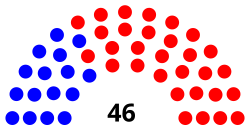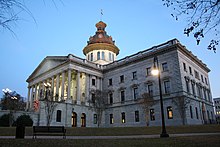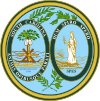South Carolina General Assembly
South Carolina General Assembly | |
|---|---|
 | |
| Type | |
| Type | Bicameral |
| Houses | Senate House of Representatives |
| Leadership | |
President of the Senate | |
Speaker of the House | |
| Structure | |
| Seats | 170 voting members: 46 Senators 124 Representatives |
 | |
Senate political groups | Republican (30) Democratic (16) |
 | |
House political groups | Republican (81) Democratic (43)[1] |
| Elections | |
Senate last election | November 2020 |
House last election | November 2020 |
| Meeting place | |
 | |
| South Carolina State House, Columbia | |
| Website | |
| http://www.scstatehouse.gov/ | |

The South Carolina General Assembly, also called the South Carolina Legislature, is the state legislature of the U.S. state of South Carolina. The legislature is bicameral and consists of the lower South Carolina House of Representatives and the upper South Carolina Senate. All together, the General Assembly consists of 170 members. The legislature convenes at the State House in Columbia.
Prior to the 1964 federal Reynolds v. Sims decision by the U.S. Supreme Court, each county doubled as a legislative district, with each county electing one senator and at least one representative. Moreover, each county's General Assembly delegation also doubled as its county council, as the state constitution made no provision for local government.
The "one man, one vote" provision of Reynolds v. Sims[2] caused district lines to cross county lines, causing legislators to be on multiple county councils. This led to the passage of the Home Rule Act of 1975, which created county councils that were independent of the General Assembly. However, the General Assembly still retains considerable authority over local government. As a result, the legislature still devotes considerable time to local matters, and county legislative delegations still handle many matters that are handled by county governments in the rest of the country.[3]
There are 124 members of the South Carolina House of Representatives, who are elected every two years, and the South Carolina Senate has 46 members, elected every four years concurrent to the presidential election. For both houses, there are no term limits. The General Assembly meets in joint session to elect judges, with all 170 members having an equal vote in such elections.
Officers[]
Senate[]
| South Carolina Senate Officers | ||
|---|---|---|
| Position | Name | Party |
| President of the Senate | Harvey S. Peeler Jr. | Republican |
| Majority Leader | A. Shane Massey | Republican |
| Minority Leader | Brad Hutto | Democratic |
House of Representatives[]
| South Carolina House of Representatives Officers | ||
|---|---|---|
| Position | Name | Party |
| Speaker | James H. "Jay" Lucas | Republican |
| Speaker pro tempore | Tommy Pope | Republican |
| Majority Leader | Gary Simrill | Republican |
| Minority Leader | J. Todd Rutherford | Democratic |
Historic Party Control[]
| Year[a] | Senate Majority |
House
|
Governor Control |
|---|---|---|---|
| 1868 | Republican | Republican | Republican |
| 1870 | |||
| 1872 | |||
| 1874 | |||
| 1876 | Democratic | Democratic | |
| 1878 | Democratic | ||
| 1880 | |||
| 1882 | |||
| 1884 | |||
| 1886 | |||
| 1888 | |||
| 1890 | |||
| 1892 | |||
| 1894 | |||
| 1896 | |||
| 1898 | |||
| 1900 | |||
| 1902 | |||
| 1904 | |||
| 1906 | |||
| 1908 | |||
| 1910 | |||
| 1912 | |||
| 1914 | |||
| 1916 | |||
| 1918 | |||
| 1920 | |||
| 1922 | |||
| 1924 | |||
| 1926 | |||
| 1930 | |||
| 1934 | |||
| 1938 | |||
| 1942 | |||
| 1946 | |||
| 1950 | |||
| 1954 | |||
| 1958 | |||
| 1962 | |||
| 1966 | |||
| 1970 | |||
| 1974 | Republican | ||
| 1978 | Democratic | ||
| 1982 | |||
| 1986 | Republican | ||
| 1990 | |||
| 1994 | Republican | ||
| 1998 | Republican | Democratic | |
| 2002 | Republican | ||
| 2006 | |||
| 2010 | |||
| 2014 | |||
| 2018 | |||
| 2022 | TBD |
See also[]
- South Carolina State House
- South Carolina House of Representatives
- South Carolina Senate
- South Carolina government and politics
- Governor of South Carolina
- Lieutenant Governor of South Carolina
- South Carolina Code of Laws
Notes[]
- ^ Years reflected in chart match gubernatorial elections
References[]
- ^ "South Carolina Legislature Online - House of Representatives".
- ^ "Reynolds v. Sims 377 U.S. 533 (1964)". Justia Law. Retrieved May 12, 2016.
- ^ "Scoppe: The Home Rule Act that didn't really allow home rule". thestate. Retrieved May 12, 2016.
External links[]
- South Carolina General Assembly
- Government of South Carolina
- Bicameral legislatures
- South Carolina stubs
